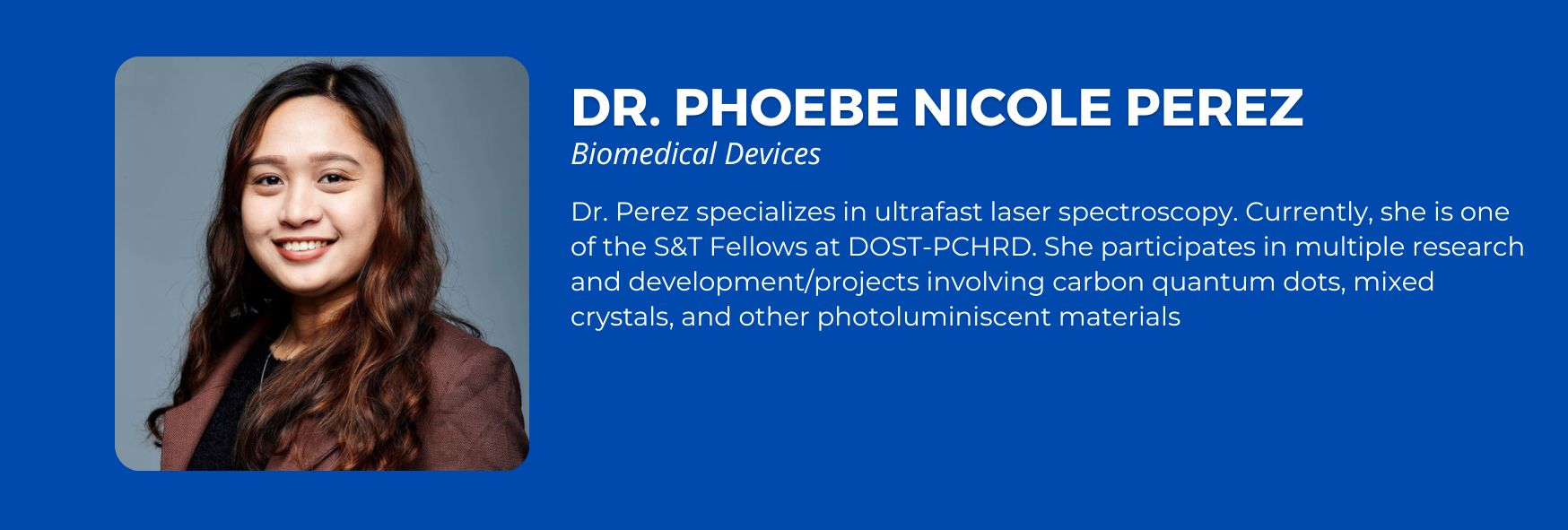
Sex: Female
Education:
- Doctor of Philosophy in Physics, National Sun Yat-sen University, Taiwan, 2021
- Bachelor of Science in Applied Physics, University of the Philippines Los Baños, 2016
Field of Specialization:
Quantum mechanics
Semiconductor optics
Statistical mechanics
Classical mechanics
Electrodynamics
Condensed Matter Physics
Researches:
Article title: Temperature-dependent photoluminescence of carbon quantum dots
Authors: Phoebe Nicole G. Perez
Publication title: Bulletin of the American Physical Society 65, 2020
Abstract:
No available
Full text available upon request to the author
Article title: Photoluminescence and time-resolved photoluminescence study of GaSe1-xSx mixed crystal
Authors: Phoebe Nicole G. Perez, Wen-Ching Chao, Li-Wei Tu, Ching-Hwa Ho, Meng-En Lee, Emmanuel A. Florido, Der-Jun Jang
Publication title: Proceedings Volume 11274, Physics and Simulation of Optoelectronic Devices XXVIII; 112742J (2020)
Abstract:
GaSe1-xSx mixed crystals have recently drawn worldwide attention owing to their wide bandgap, which can be tuned by varying the ratio between Se and S. We have addressed the scarcity of comprehensive studies on its dynamic properties by investigating the photoluminescence (PL) and time-resolved photoluminescence (TRPL) of GaSe1-xSx (x = 0, 0.1, 0.2, 0.5) mixed crystals at different temperatures (14 – 300 K) using 404 nm excitation from a Ti:Sapphire laser. This paper aims to show that the PL spectra and the lifetime of GaSe1-xSx could be used to determine the stacking type and composition of the sample. Three Gaussian peaks were deconvoluted from the obtained PL spectrum and were attributed to excitons from the direct and indirect bandgaps. As the sulfur composition increases, the color of the emission changes and the PL spectra exhibits a blueshift. Selenium-rich samples, which have a ε-stacking, have an orange emission while sulfur-rich samples, which have a ε-β mixed stacking, have a yellow to green emission. TRPL results reveal that the lifetime becomes longer as the sulfur composition increases. The stacking type influences the separation and transfer of the carriers. Hence, sulfur-rich samples have a significantly longer lifetime than selenium-rich samples due to their β- stacking. As the temperature increases, the lifetime also becomes longer due to the increase of the non-radiative recombination rate, which plays a dominant role in the PL emission. These results are useful for the development of GaSe1-xSx-based optoelectronic devices in the red to the blue visible region.
Full text available upon request to the author
Article title: Photoluminescence of CuInSe2/GaN and CuInSe2/InN
Authors: Phoebe Nicole G. Pereza Cheng-Chang Yu, Cheng-Hung Shih, Chen-Chi Yang, Emmanuel A. Florido, Dah-Chin Ling, Der-Jun Jang
Publication title: Journal of Luminescence 213:364-369, September 2019
Abstract:
The power and temperature dependent photoluminescence (PL) of epitaxially grown In-rich CuInSe2 (CIS) and Cu-rich CIS deposited on N-polar GaN and InN were investigated in this paper. The In-rich CIS/GaN has two PL emissions characterized by a donor-acceptor pair (DAP) peak at 0.92 eV and an excitonic peak at 1.08/1.1 eV. On the other hand, the Cu-rich CIS/GaN has four PL emissions characterized by two DAP peaks at 0.86 eV and 0.94 eV, free-to-bound recombination peak at 0.97 eV and an excitonic peak at 1.03 eV. Identification of these defects in the CIS absorber layer is crucial for the improvement of the device efficiency. The PL emission of the CIS/InN closely resembles that of the Cu-rich CIS/GaN. For all the samples, the PL intensity increased with excitation power while the PL intensity decreased with temperature. The obtained power coefficients and activation energies support the proposed mechanism causing the luminescence. The defects present in CIS/GaN and CIS/InN were also identified. The results from this study are consistent with those of CIS single crystals and show that the CIS absorber layer can be incorporated with III-nitride materials, and its absorption can be extended beyond the spectrum covered by plain CIS.
Full text available upon request to the author
Article title: Conducting Properties of Polyaniline Emeraldine Salt on Paper in the Low-Frequency Region
Authors: Phoebe Nicole G. Perez
Conference title: 2017 International Conference on Frontiers of Composite Materials
Abstract:
Polyaniline emeraldine salt (PAni-ES) was successfully deposited on paper through layer-by-layer technique. In this method, a paper was alternately dipped in aniline monomer and an oxidizing agent for different dipping cycles. This process produced green PAni-ES on paper. The morphology of the samples showed polymeric networks with pores, fiber-like structures and aggregates. There is a transition from frequency-independent to frequency-dependent conductivities of the samples. The conductivity increased with increasing number of dipping cycles. The frequency-dependent conductivities follow the power-law behavior reflecting conducting network and hopping mechanisms. Lastly, the conductivities with frequency followed a scaling behavior reflecting a common physical mechanism in PAni-ES on paper.
Full text available upon request to the author
Contact details: This email address is being protected from spambots. You need JavaScript enabled to view it.